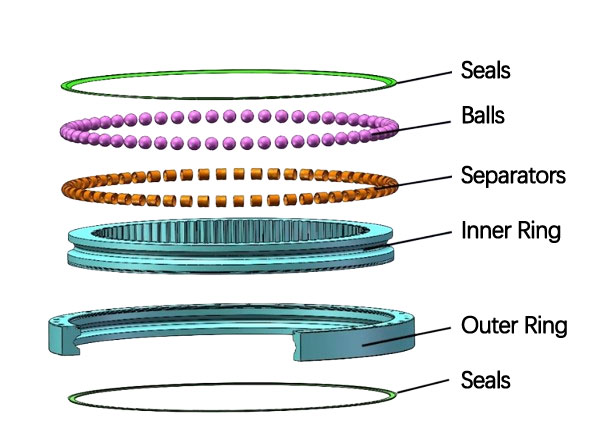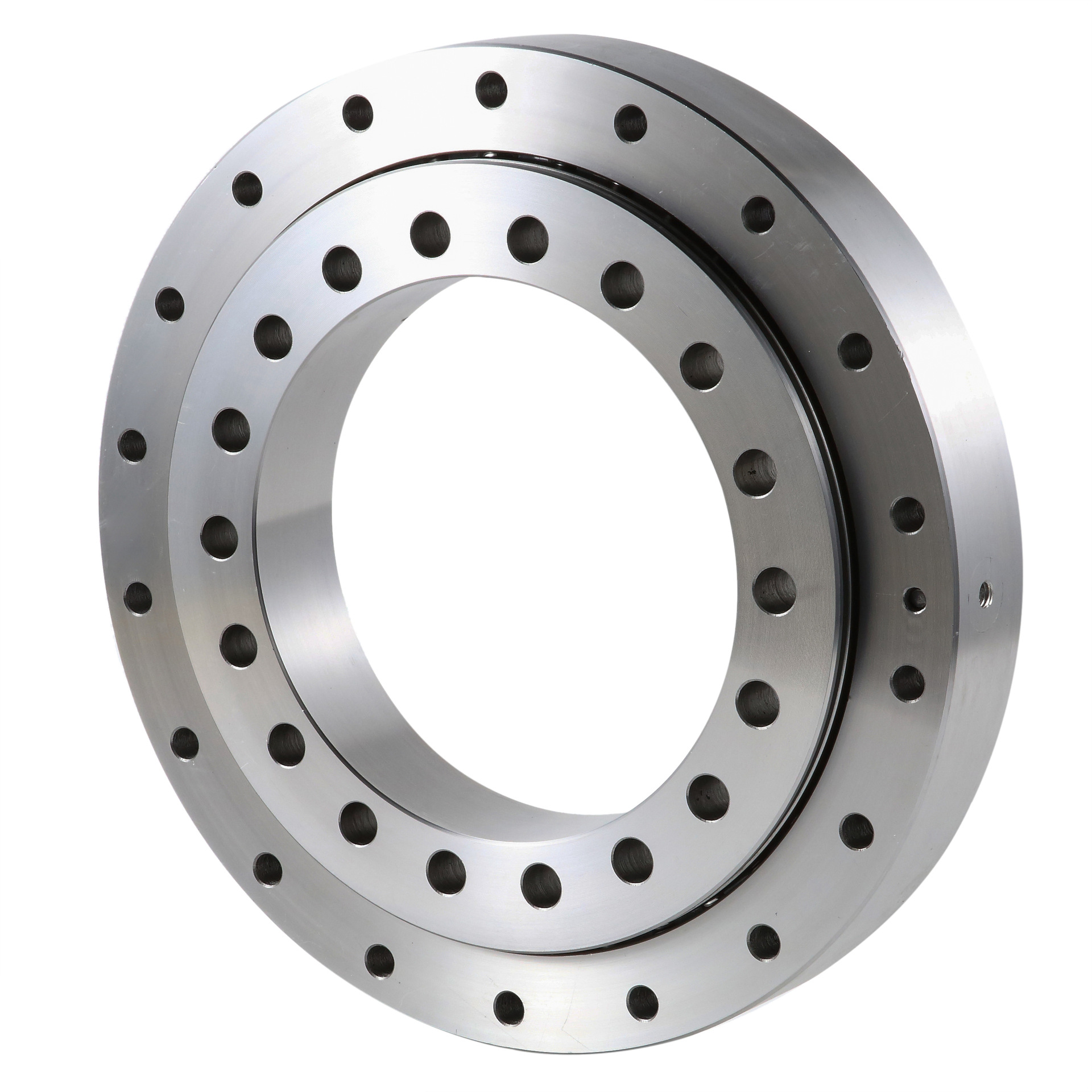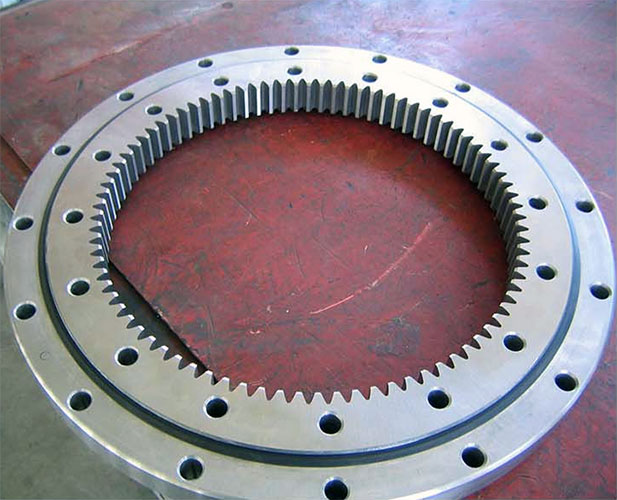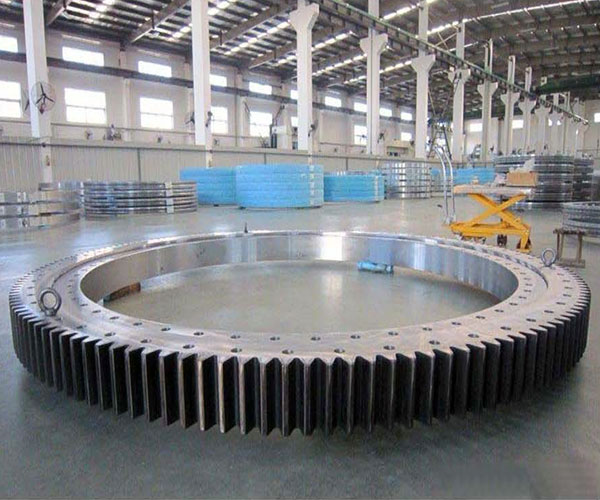
Overview
Single-Row Four-Point Contact Ball Slewing Bearings are compact, high-performance rotational components designed to handle combined loads with exceptional efficiency.
These bearings feature a unique design where each ball makes four contact points with the raceways, enabling them to simultaneously accommodate axial, radial, and moment loads from multiple directions. View Our Factory ProductsStructural Composition
- Outer Ring – The stationary component with precision-machined raceways
- Inner Ring – The rotating element with matching raceways
- Balls – High-grade steel balls that transmit forces between rings
- Separators – Maintain precise ball spacing and prevent contact
- Sealing System – Protects against contaminants and retains lubrication
- Mounting Holes – For secure installation to machinery
Four-Point Contact Principle
The defining characteristic of these bearings is the special “gothic arch” raceway geometry that creates four distinct contact points between each ball and the raceways:
- Two contact points with the outer ring raceway
- Two contact points with the inner ring raceway

Load Capacity
Single-row four-point contact ball slewing bearings are engineered to handle three types of loads simultaneously:
- Axial Loads – Forces parallel to the rotation axis
- Radial Loads – Forces perpendicular to the rotation axis
- Moment Loads (Overturning Moments) – Tilting forces that create rotational torque
Performance Advantages
- Compact cross-section
- Low rotational torque
- High rotational accuracy
- Cost-effective solution
- Easy installation
Gear Configuration Options
Non-Geared Type

- Simplest configuration
- Direct drive applications
- Minimal maintenance requirements
- Most cost-effective solution
- Compact design with minimal protrusions
Internal Gear Type

- Gear teeth cut on inner ring bore
- Protected gear location
- Reduced contamination risk
- Compact external dimensions
- Preferred for space-constrained applications
External Gear Type

- Gear teeth cut on outer ring circumference
- Easier maintenance access
- Higher torque transmission capacity
- Simpler lubrication access
- Wider pinion gear selection
Typical Applications
Construction Machinery
- Small to medium-sized excavators
- Mobile cranes (up to 50-ton capacity)
- Concrete pump trucks
- Aerial work platforms
- Compact loaders
Industrial Equipment
- Material handling turntables
- Packaging machinery rotators
- Welding positioners
- Indexing tables
- Light-duty wind turbine yaw systems
Selection Considerations
| Factor | Consideration | Recommendation |
|---|---|---|
| Load Capacity | Axial, radial and moment loads | Calculate all load components including dynamic factors |
| Gear Type | Non-geared, internal or external gear | Determine based on drive system requirements and space constraints |
| Mounting | Surface flatness and stiffness | Ensure mounting surfaces meet ISO standard tolerances |
| Operating Environment | Temperature, contaminants, corrosion | Select appropriate seals and lubrication |
| Rotational Speed | RPM requirements | Consider centrifugal forces at high speeds |
Maintenance Recommendations
- Regular lubrication intervals based on operating conditions
- Periodic inspection of seals for damage or wear
- Check for abnormal noise or vibration during operation
- Monitor gear teeth for proper meshing and wear patterns
- Keep mounting surfaces clean and properly torqued
Technical Specifications
Standard Sizing
- Bore diameters: 100mm to 2000mm
- Axial load capacity: 5kN to 1500kN
- Radial load capacity: 3kN to 800kN
- Moment capacity: 10kN·m to 1500kN·m
Material Specifications
- Rings: 42CrMo/50Mn alloy steel
- Balls: GCr15 bearing steel (HRC 60-65)
- Separators: Nylon 6/6 or brass
- Seals: NBR rubber with steel reinforcement